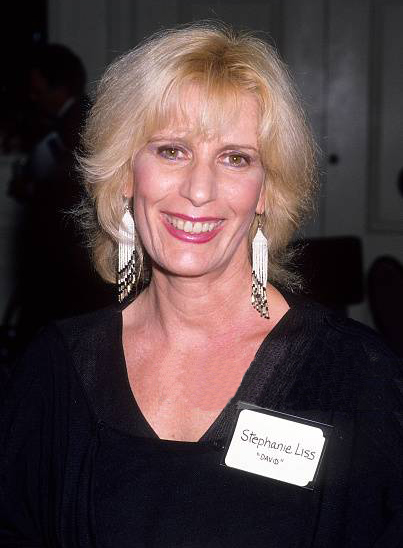
A prolific writer of television movies and miniseries, STEPHANIE LISS was one of the few women writers working in television movies and miniseries, during the time in which she was building her career – a successful career spanning over thirty years in television and theatre. Although born and raised in NY, her family moved to Los Angeles, immediately following her Junior High School graduation, but Stephanie longed for New York, and after early graduation from high school, and acceptance at NYU TISCH SCHOOL OF THE ARTS, THEATRE PROGRAM, she was back home in NY, as one of the two youngest students ever to attend Tisch. Because there was no playwrighting program at Tisch at that time, Stephanie trained in the acting world. In that training, Stephanie learned more about writing, than she ever could have dreamed. She studied with the best… The great Lloyd Richards, director of RAISIN IN THE SUN, Omar Shapli, of Second City, Peter Kass, director of THE SIGN IN SIDNEY BRUSTEIN’S WINDOW, Andre Gregory, of the famed MANHATTAN PROJECT’S ALICE IN WONDERLAND, Olympia Dukakis, and on, and on, and on… That training shaped the writer she became…

After graduation, Stephanie remained in NY for a year, before moving back to LA, vowing to return home to NY, as soon as possible. As destiny would have it, Stephanie’s career as a writer took off soon after, and she found herself happily entrenched and rooted in the world of television movies and miniseries. Still in her early twenties, Stephanie learned and grew on the job, making her bones, as she says, in the arena of movies based on truth, and hard hitting issues. She had the great privilege and honor of working with some of the finest, most revered, producers in television. In their notes’ sessions, Stephanie learned the art and craft of writing, one of the most important lessons being – good notes make better writers. If the notes aren’t right, don’t make the changes. Even during that time, Stephanie’s approach to her work was unique. In order to be able to create the most realistic and wrenching portrayals, Stephanie knew she had to live her stories. If the story was about the Children of Skid Row – as was the first movie she sold to CBS television, Marion Rees Productions – she moved into a flop house on Skid Row, until she had a feel and a sense of the children, and the place. That Skid Row script was the beginning of her journey of research as an integral part of her work. And it was the beginning of her career, as she became known for tackling the subjects that no one else was willing to explore. And even though young, she was the only woman tackling these projects in this way.
As the stories and subjects became more complex and dangerous, she was often told she could not do the kind of research for which she was becoming known, but she never heard the word, no. The more impossible the job, the more she thrived on it, often calling herself, an adrenalin junkie, for the work took Stephanie into the dark places of the world. In order to breathe life into the scripts, and make them real and often haunting, the research took Stephanie from the streets of Skid Row, to the farms and cattle ranches of Oklahoma and Kansas, the inside of the KU KLUX KLAN, Klan cross burnings and family meetings in Idaho, Nebraska, Wisconsin, and Illinois, and the ARYAN NATIONS and CHRISTIAN IDENTITY survivalist training camps in the hills of the Dakotas, to the WAR IN LEBANON, underground with HAMAS, PLO, YASSER ARAFAT, MAHMOUD ABBAS, AL AQSA, to the CHILDRENS TERRORIST TRAINING CAMPS at Arafat’s compound, in Tripoli Lebanon, and the IDF CAMP overlooking Beirut, during the war. She lived and traveled with the MASAI in Kenya, and went into the CONGO with JEWISH WORLD WATCH, to the women and children who were raped, and used as weapons of war, and the CHILD SOLDIERS, both in their soldier camps, as well as the private debriefing centers, where they were housed, after having been brought back for rehabilitation. All of these…
All of these have been because of the kind of writer, Stephanie is. She has always been welcomed onto the set of her television movies, and has gone on location with them, overseas as well as around the streets of Los Angeles.
It takes a great deal to have a movie greenlit, and Stephanie has had eight movies made so far, in the course of her career. Among those are some of which she is most proud, and feels most privileged, to have been asked to write –
SECOND SERVE – THE RENEE RICHARDS STORY – CBS – starring Vanessa Redgrave as the famed tennis pro/acclaimed eye surgeon, directed by Anthony Page. This was the first television movie about transsexuals, and the first to bring the struggle of the trans world, to an American audience. In order to get a sense of it all, Stephanie became Renee Richards’ shadow. She followed Renee onto the tennis court, into the operating room, into the trans world, and spent time with Renee at her home in Connecticut. It was an extraordinary journey, both as a writer, and as a woman. Seeing it all through Renee’s eyes… This movie was nominated for a Golden Globe, an Emmy, and Vanessa was nominated for an Emmy. Stephanie received the WOMEN IN FILM LUMINAS AWARD, for the outstanding portrayal of a woman ….
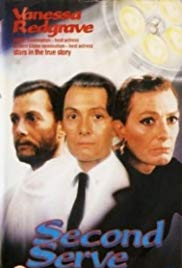
DAVID – THE DAVID ROTHENBERG STORY – ABC television – starring Bernadette Peters, as David’s mother, Marie Rothernberg, whose six year old son, David, was set on fire by ex husband, Charles, (John Glover), David’s father, to punish her for their divorce… Directed by John Erman, score by Marvin Hamlisch, and produced by Jack Grossbart, this was the dream team, for only her second movie. To research this, Stephanie spent weeks with David and his mother, Marie. She went into Soledad Penitentiary, to interview Charles, David’s father, and went into the burn wards, at Sherman Oaks Burn Center, and Childrens Hospital, L.A. It was an upsetting journey, and a healing one… For this, the movie was nominated for an Emmy, a Peabody Award, and Stephanie was nominated for a Writers Guild Award, and received special recognition from Children’s Hospitals Association.
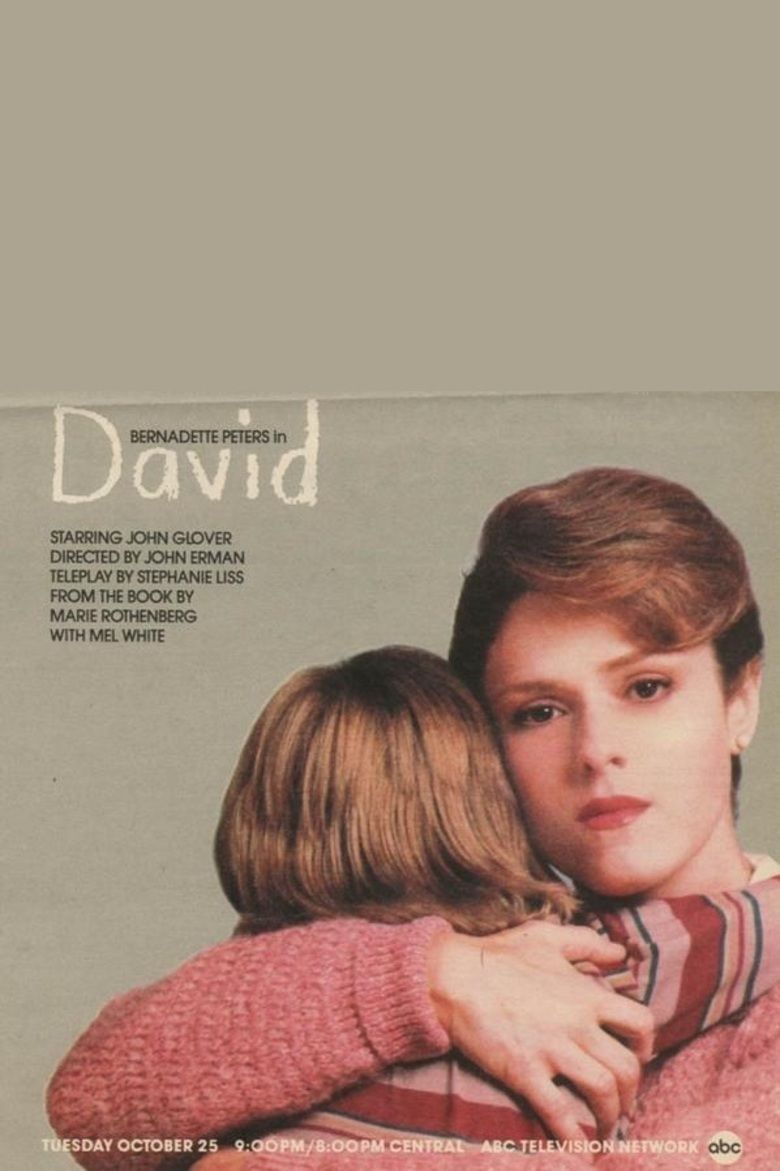
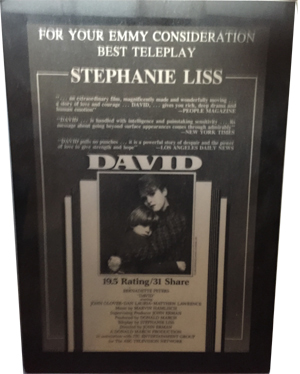
SHAMEFUL SECRETS aka GOING UNDERGROUND – ABC television – starring Joanna Kerns, Tim Matheson, LaTanya Richardon. Directed by Tony nominee, David Jones… The first film to address custody issues, where domestic violence of a partner, has been involved. At the time, in the U.S. there were no laws protecting women who had been victims of domestic violence, where custody issues were involved, in divorce cases. Stephanie was requested as writer, by former Congresswoman, Constance Morella, Md. Stephanie’s work had received attention, and the Congresswoman was aware of the issues she had tackled, and specifically asked that she write the film. In these custody cases, domestic violence was not admissible in court, because there were no witnesses. It was regarded as hearsay. Congresswoman Morella introduced a bill that would require individual states to sign on, permitting domestic violence to be admitted in court, so that the women would not lose their children. There were still 16 state hold outs, at the time that Stephanie wrote the film.
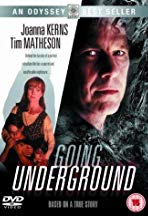
Stephanie researched extensively – moving into a women’s shelter, and working with the women. Stephanie understood too well – she had lived her own, #metoo, story. She gathered the stories, and created a composite situation. In addition to spending time with the women, she spent time with the abusers, as well as their children, and was invited to Congress by Congresswoman Morella, to get an inside view of the life of a bill. When the movie was made, it was screened before Congress, and as a result of the impact of the film, the holdout states signed on, and the bill became state law, in all fifty states. The film was also screened in women’s prisons across the country, where women were incarcerated for murdering their abusive spouses, in order to save their lives, and the lives of their children. Stephanie was invited into women’s groups in prisons to talk about the options open to these women. The film was recognized by several congressional councils, as well as individual states. It was recognized by the Berlin Film Festival, as well as the AFI, for outstanding television.
HIDDEN IN SILENCE – LIFETIME television – Starring Kellie Martin, Marion Ross, and Joss Ackland. Directed by Richard Colla. Hidden in Silence, is the story of a young Polish Catholic woman, who hid thirteen Jews in her attic, during WWII, at great risk to herself, and her younger sister, for whom she was caring. Their mother had been conscripted to Germany to work, leaving them alone. The young woman, was Fusia. Her real name, Steffie. To research this film, Stephanie was instrumental in bringing the survivors together with Fusia, for the first time in over fifty years. She spent time with each, getting their stories, and spent time with Fusia and Max, Fusia’s husband, and the first survivor whom Fusia rescued. Fusia had worked for Max’s parents, in their Jewish bakery/sweet shop, in Poland, and when the Nazis invaded, Max’s mother sent Fusia back to her home, because she knew they, as Jews, would be taken away. Eventually, Max escaped, and made his way back to Fusia’s family home, and she was able to hide him. From Max, came twelve other Jews, in hiding. At great risk to her and her sister, Fusia took them into her attic, where they lived in unbearable conditions, for two and a half years, until the Russians liberated them. Max and Fusia eventually married, and every survivor thrived, after the war, creating future generations for their families. Fusia was given a spot on the walk of the righteous, in Jerusalem, and the movie is screened at the National Museum of the Holocaust, in Washington D.C. Hillary Clinton placed the film in the National Archives of the U.S., and it was screened for the Royal Family, in Great Britain, at the late Princess Diana’s request. Stephanie won a Writers Guild Award, for Outstanding Original Drama, and the film won the Berlin Film Festival, for television. The movie received recognition from the Peabody Foundation, as well as the Los Angeles Film Critics Association, for Television.
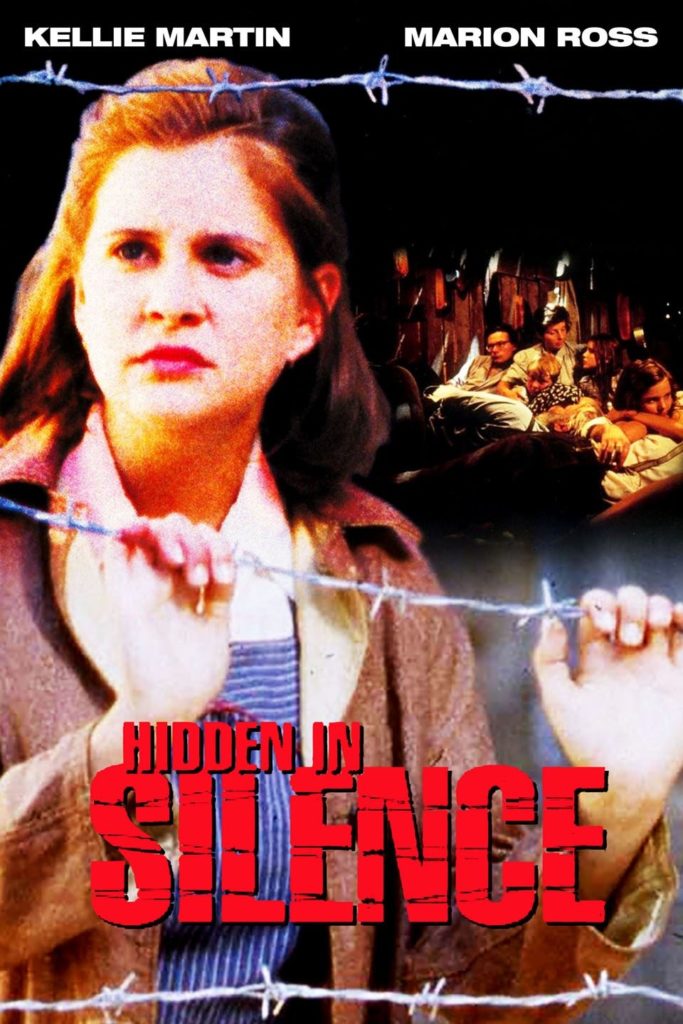
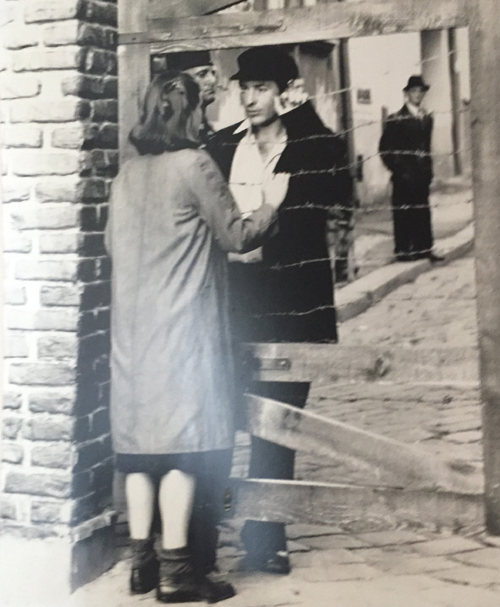
FOR THE FUTURE – THE STORY OF THE IRVINE FERTILITY SCANDAL – LIFETIME television – Starring Marilu Henner. This film is the story of Dr. Ash, who was hyper fertilizing women who came to him for help, causing them to produce thousands of eggs, which he was implanting in countless other women, as well selling on the black market. The late Senator Tom Hayden, was determined to arrest Ash, prosecute him, and revoke his medical license. U C Irvine, destroyed their records of Dr. Ash, and refused to cooperate. Sen Hayden was instrumental in the research, turning over his private files to Stephanie, and helping her with entré. When Stephanie was threatened, and the University threatened to have the film shut down, the Writers Guild of America intervened on her behalf, as did Senator Hayden, claiming censorship. In spite of the threats, Stephanie went on, and Senator Hayden was able to have Ash prosecuted. Because Ash had fled to Argentina, he was sentenced in absentia. If he ever returns to the U.S., he will be arrested on sight. The Irvine Fertility Clinic was shut down.
ONE SURVIVOR REMEMBERS – the Story of Gerda Weissman Klein – HBO Films Documentary – This story is very close to Stephanie. She accompanied Gerda back to the former Czechoslovakia, along with Gerda’s husband, Kurt, their children and grandchildren, and several leaders of the Los Angeles Jewish community. It was a very emotional, moving, journey, tracing Gerda’s life during the Shoah, from work camp to work camp, death marches, and finally, liberation. It was Kurt who had liberated Gerda, and from that moment, they fell in love. Gerda had lost her entire family, and Kurt became her lifeline. He nursed her back to health, and stayed with her, loving her, marrying her, creating a family with her, until his death. On that trip, Stephanie became close to the Klein family, and acquired the rights to Gerda’s story, and Gerda’s autobiography,,’All But My Life.’ For several years, Stephanie tried to sell it as a movie, but the answer was always the same – no more Holocaust stories. And so it was, until HBO called, wanting to make a documentary of Gerda’s life, and Stephanie and Gerda, jumped. Stephanie laid out the vision and story she had for the film, and translated it to the documentary. Because Stephanie was busy writing HIDDEN IN SILENCE, at the time, she was unable to write, ONE SURVIVOR REMEMBERS, however, she did executive produce it, and the documentary went on to win the ACADEMY AWARD for Best Documentary Short Feature, of that year. It was an honor and a privilege to bring Gerda’s story to the world. The documentary is shown on a loop at the National Holocaust Memorial Museum, in Washington D.C., and has received recognition from groups all over the world.
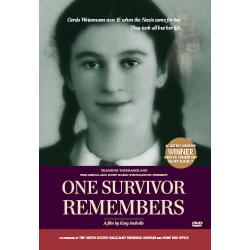
These are but a few of the movies and awards, in Stephanie’s credits. The other movies to her credit, are, A CHILD LOST FOREVER, starring Beverly D’Angelo, RUNAWAY FATHER, starring Donna Mills, and under the pseudonym of JULIA MINSKY, BADGE OF BETRAYAL, starring Harry Hamlin. Each of her movies has had some kind of social impact, including the lesser ones in her filmography. In 2010, Cinemathique held a retrospective of some of Stephanie’s television movies, highlighting SECOND SERVE.
THEATRE
Even though Stephanie built her career in television, her roots and a great part of her heart, are in theatre. Theatre is Stephanie’s first love, and her plays have been produced all over the US, with productions in Israel, as well.
While inundated with television projects, Stephanie longed to find her voice again, as a playwright. At the same time this transformation was occurring, she began to feel even more drawn to her Judaism. For Stephanie, there was a deep connection between the two – an expression that would take flight, in her plays. Following the pull, Stephanie was invited into a Torah study group of artists in her business, and it was there that she met the founders and directors of the CENTER FOR JEWISH CULTURE AND CREATIVITY. Stephanie was invited into their midst, and from that association, she was honored to become the first PLAYWRIGHT IN RESIDENCE, for the Center. Through the Center, her plays were produced in SAN DIEGO, at the SAN DIEGO REPERTORY THEATRE, in ISRAEL, and throughout Los Angeles. Her first play, was –
THE VOW – Based on true story about two men, one Israeli, one Palestinian, raised as brothers, and torn apart by conflict and war. Stephanie originally developed The Vow, for CBS Television as a movie special. She was in the middle of another movie for CBS at the time when this story came to her through a phone call from a cousin, in Israel, in the middle of the night. The minute she heard the story, she knew she had to write it. It was during the time of the first war in Lebanon. Part of the story took place there, and part in Israel. In the middle of the war. In the middle of the PLO compound. She knew she had to go. She called her agent, waking him, and telling him the story ,and that she had to go into the war in Lebanon. Immediately. The next morning, he called the producers for whom she was in the middle of writing her current project, they called CBS, and CBS bought the Israeli Palestinian story over the phone. A week later Stephanie was in Lebanon, in the middle of the war, going underground with Arafat, Abbas, and the PLO, and the Israeli Army, the IDF. The IDF kept track of Stephanie, and when things became too heated for her in Beirut, and with the PLO, they brought her to their camp in the mountains above Beirut, and on to Israel. With them she traveled to the front lines in the Bekka Valley, into the Palestinian refugee camps with Palestinian elders, and ultimately, with the Mossad. Upon her return, all of this became a part of her story, weaving the moments into her script. CBS ultimately did not make the movie, but Stephanie could not let it go, and with her longing to jump between theatre and television, she rewrote THE VOW, as a play.
THE VOW was produced by the Center for Jewish Culture and Creativity, in San Diego, at the San Diego Repertory Theatre, as well as at the JCC, in West Hills, California, and at JCCs around the U.S., and the Cultural Center, in Israel, and at the Arad Arts Institute, in Arad, Israel. It was her first foray back into theatre, as a playwright.
As a result of The Vow, Stephanie was given an award for Outstanding Contribution, to the Jewish Community, and won Outstanding New Play, at the San Diego Jewish Arts and Theatre Festival.
Immediately following the success of THE VOW, Stephanie wrote FACES OF WAR, the story of Israelis affected by war. FACES OF WAR was produced by the 92 St Y/Makor, in NY, and special performances were given to the delegations of the United Nations, at their request. Faces of War was extended, and the play traveled to Denver, to the Maisel Arts Center, where it ran for six weeks – the longest running play they had produced to date. Stephanie won OUTSTANDING NEW PLAY AWARD, and the play received rave reviews.
DAUGHTER OF MY PEOPLE, followed. The story of Henrietta Szold, the founder of Hadassah, and one of the true founders of the state of Israel, Daughter of My People is a one woman, one act, play, focusing not only on the life work of Henrietta Szold, but on her life as a woman, in a time that was profoundly void of women of action and achievement. She was a woman of firsts, and she stood up for the rights of all people. It was a particularly poignant and challenging time in Szold’s life, during WWII, when she was smuggled into Hitler’s Germany, to meet with the parents of the Jewish Bund in the Berlin Underground. Those parents begged her to help get their children out of Germany, and so she started the Youth Aliyah program, rescuing and saving tens of thousands of Jewish Youth, who grew to create and build Israel. Daughter of My People, had a very successful run in Chicago, produced by Genesis Theatricals, and was chosen as the Best Play during the Festival of Women’s Plays. From Chicago, Daughter of My People, was produced in Los Angeles, at the MET THEATRE, and had performances at the Skirball Cultural Center, and later became part of Stephanie’s play, On Holy Ground…
ON HOLY GROUND, a play about two mothers, one Israeli, the other Hamas, both with sixteen year old daughters, just beginning to come into their own. There is a suicide bombing at the bus station in Jerusalem – the Israeli daughter is killed, and the Hamas daughter is the bomber. On Holy Ground, is the story of these two mothers, their children, the inextricable connection they share, and the diverse paths of their lives. Stephanie researched this play, once again by going underground with Hamas, and observing the army training camps for the suicide bombings, starting in Hamas classrooms of Gaza. She bore witness to the training of the young suicide bombers, and met with mothers of child martyrs for Hamas. She went into the groups of grieving mothers, both in Israel and Gaza, and was allowed to sit in on a session between an Israeli mother who had lost a child in a bombing, and a Hamas mother, whose child was the bomber. The meeting affected Stephanie, profoundly. From that meeting, ON HOLY GROUND, was born.
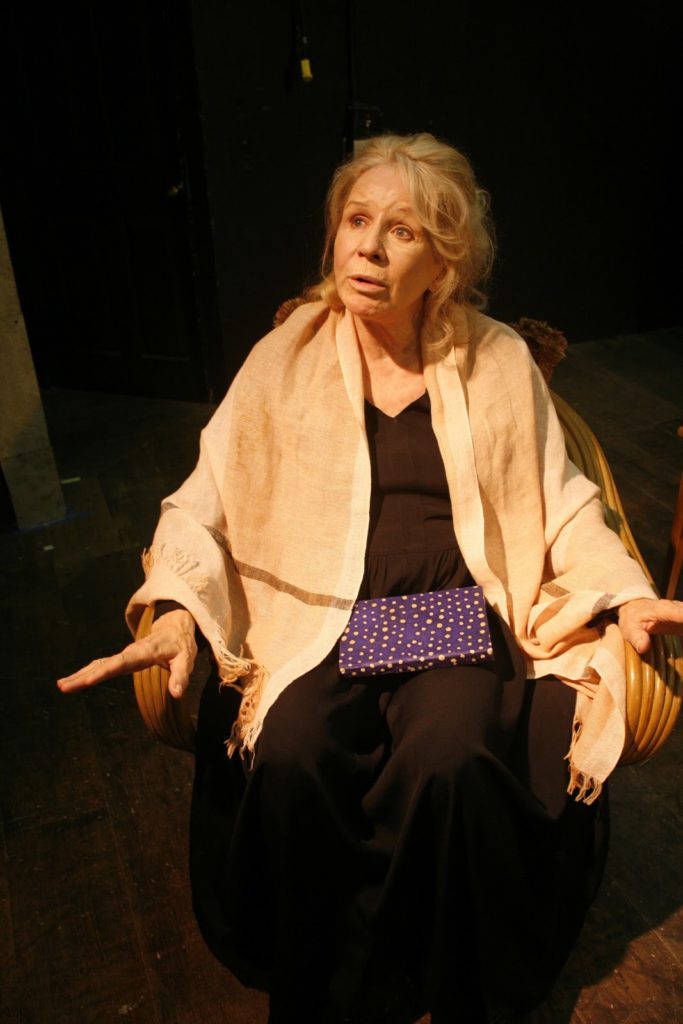
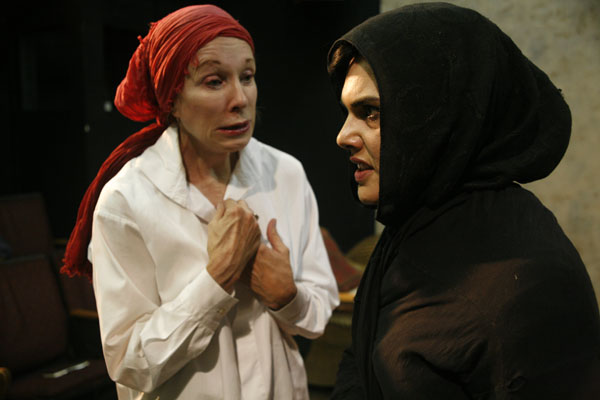
photo by Irene Hovey
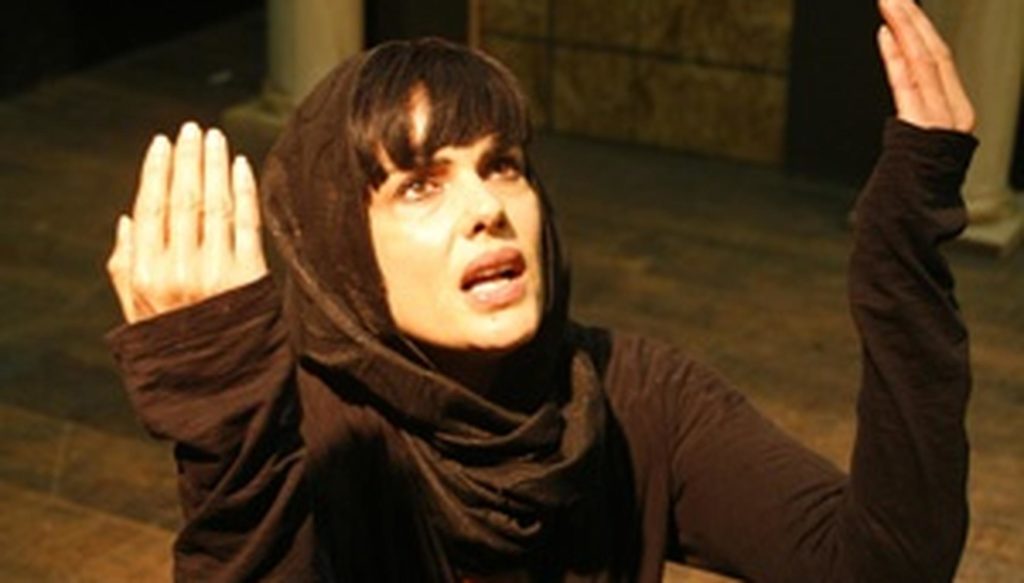
photo by Irene Hovey
As a first part of the play, to give background to Israel’s position in the world, Stephanie included Daughter of My People, as a prologue. It was a powerful pairing, and once again, Genesis Theatricals, under the artistic direction of ELAYNE LETRAUNIK, produced it in Chicago, where it ran for a month, with an extension. The Israeli Consulate in Chicago, invited their audience. It was a powerful experience, and received wide notices. Following the Chicago run, ON HOLY GROUND, was produced at the MET THEATRE, in Los Angeles, where it ran for five and a half months, originally booked for six weeks, the demand was so great, it was extended, twice. At the MET, the great Salome Jens, portrayed Henrietta Szold, but as it went out to groups on its own, as a one act, one woman play, with a powerful score by RebbeSoul, Ellyn Stern took over the role, and because the response to this play was so great, people were requesting a recording, with the score. So Stephanie, RebbeSoul, and Ellyn, went into a studio, and recorded it as a download.
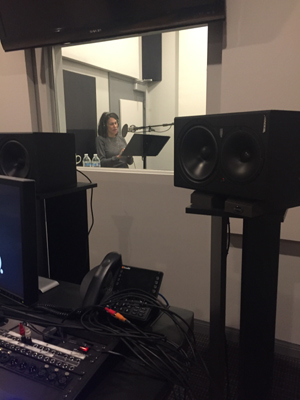
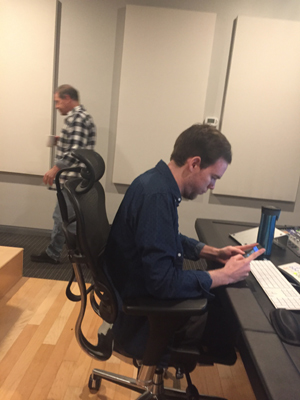
During this time, Stephanie was involved with Jewish World Watch, in Los Angeles, on their policy and advocacy committees. Jewish World Watch is a Los Angeles, grass roots organization, that was created after the Rwandan genocide, to be a witness and support to those who were, like Jews, survivors of genocide. It was founded by Rabbi Harold Schulweis, z’l,of Temple Valley Beth Shalom, and Janice Kamenir Reznik, a prominent congregant, and friend of the Rabbi’s. Jewish World Watch, or JWW, as it is known, was instrumental in saving the lives of the women and children of South Sudan, with their Solar Cooker project, and went on to the Congo, where genocide and war were fierce. Women and children were/are, being used as weapons of war, by the Congolese soldiers. They were Hutu militia, who had hidden in the mountains of the Congo, following their murderous genocide in Rwanda. When Stephanie heard the stories coming out of the Congo, she knew she had to write a play, and that began a journey that was to take her in a direction she had not been before…
JWW made trips to the Congo regularly, and Stephanie approached them with the idea of writing this play, and for her research, accompanying them to the Congo. It took awhile to gain consent, but ultimately, she wore them down, and on their next trip to Rwanda and the Congo, Stephanie went with them.
She traveled with them into the hospitals and rape wards, and into the hills to the villages of women, that JWW had been supporting. Before she left for the Congo, Stephanie had requested of JWW, to meet the men who were raping the women, and to meet child soldiers. Her request was honored, and somehow, JWW was allowed into the very violent, dangerous, men’s prison in Goma, as well as into the child soldier camps, and rescue centers. Stephanie was able to spend time with the child soldiers, and the man who rescued them, himself with a price on his head, for bringing the young soldiers back. And the women… the women who had been raped and tortured, opened up to Stephanie, bringing her into their world. Out of this trip, SISTER AFRICA, was born, while at the same time, Stephanie’s play, JIHAD, was being produced in Chicago, once again, by Elaine LeTraunik…
JIHAD is the story of the two mothers, Israeli and Hamas, taken even more deeply, into their lives… The first act is the story of the Israeli husband, a major in the IDF, and the young male teacher, who trains Hamas children to be suicide bombers. Stephanie’s play opened the way for discussion and argument, and created controversy in Chicago. It was forced to move to another theatre, following the first week of the run, because of threats. It is a powerful telling of the inner workings of Hamas, and a reflective, detailed, account of the response by the IDF. Synagogues, churches, and schools, bought out the theatre, and discussions were widely held. When Stephanie came back from the Congo, she was able to spend time in Chicago to see the play, and participate in the talkbacks. While it was a success there, her focus became SISTER AFRICA, and translating the horror and tragedy, she had witnessed.
Even though Stephanie had built her life and career, on telling the stories that centered around issues and stories of the human condition, Sister Africa, was the toughest piece she had ever written. It was one of the most raw, and she knew it would be hard to watch, if not done properly. For the first time, Stephanie had trouble finding her way into a story. Until Yom Kippur, 2015…
On Erev (evening), Yom Kippur, Stephanie was in her Jewish Renewal synagogue, B’nai Horin, in Los Angeles, preparing for the night of prayer, as the musicians entered. One musician in particular – REBBESOUL – was there. She knew his music, which was iconic, but had never heard him live. That night, when he played one of his signature pieces on his guitar, Avinu Malkeinu, Stephanie walked to the rear of the sanctuary, put her tallit over her head, and went within, as he played. It was haunting, and powerful, and as she listened, suddenly SISTER AFRICA, unfolded inside her. She knew that song, had to be the center of the piece, and there had to be a fusion of African music, as well. She and RebbeSoul – Bruce Burger – talked into the night, and out of that talk, on that Yom Kippur eve, a partnership was born. She not only worked with him to make his Avinu a part of Sister Africa, but she asked him to score all of her plays, as though they were films. And he said, yes. That was the beginning…
When SISTER AFRICA opened in Chicago, at the ATHENAEUM, it had rave reviews, a stellar cast, and sold out houses. It was the story of the work of Jewish World Watch on the ground in the Congo, but on a deeper level, it was the story of two women – one Jewish from Los Angeles, and the other Congolese, who had been raped, and whose husband and children had been killed. It was also the story of a child soldier, and the man who rescued him, and how the Jewish woman bore witness to all of it, creating a bond with the Congolese woman.
Video by Bruce Burger (RebbeSoul)
Cast of Sister Africa – in order of appearance
Takesha Meshe’ Kizart
James Binns
Chris McClellan
Ahmed Brooks
Melissa Nelson
To help get the sound of the music of the Congo, Stephanie took RebbeSoul, a world music authority, to the Congolese Church in South L. A., where he recorded members of the Congolese choir. The music is as powerful a part of the story, as Stephanie’s words.
SISTER AFRICA, received a great deal of press, including an interview Stephanie gave to NPR, WORLD VIEW, and a full page story in Broadway World.
The play is new in the world, and it is also ancient. It is the story of the abuse of power, the abuse of women and children in times of war, and in these times of misogyny, a #metoo story, unlike any that have been seen. Audiences were spellbound by the play, drawn into the tragedy, and the horror of that world. All too real, it is a story that is happening now, in too many parts of the world.
Talkbacks after every performance were magical, and lasted until the theatre asked everyone to go home. And then the discussions carried over into the street, in front of the theatre. Stephanie, the actors, RebbeSoul, were mobbed. It became an event, and people were talking about it. If the theatre had not been immediately booked, Sister Africa would have been given an extended run. It was a courageous production, and it appealed to a very diverse audience. Not only the Black and Jewish communities, but schools, shelters for abused women, churches, Hispanic community – it was one of the most widely seen shows in Chicago, and one of the most rewarding experiences for both Stephanie and RebbeSoul, as well as the actors. Stephanie has since rewritten parts of SISTER AFRICA, creating new sections that have never before been seen. It is currently in preparation for NY…
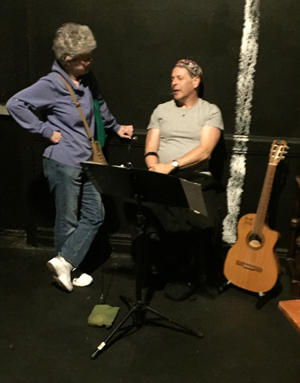
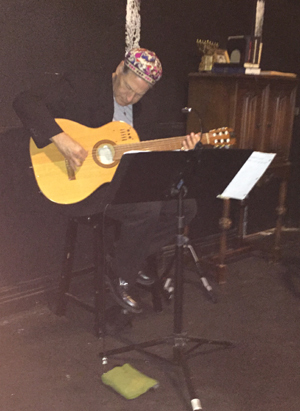
As a writer, Stephanie has been privileged and honored to have experienced parts of the world, both overseas, and in the U.S., that few have ever dreamed, and she believes it is her responsibility as a writer, to not only reflect the times, but to help change the times, heal the times, and create the times.
Her work raises as many questions as answers, and not only with SISTER AFRICA, but as with JIHAD, ON HOLY GROUND, FACES OF WAR, the talkbacks are long, and extraordinary.
In the Congo, with JEWISH WORLD WATCH, Stephanie was privileged to spend time with NOBEL PRIZE WINNER, DR. DENIS MUKWEGE, who took the JWW group on a tour not only of his hospital, but to the site of his new hospital for the women who had been raped and tortured, and the school for their children.
While several of Stephanie’s earlier plays have focused on Israelis and Hamas, or more moderate Palestinians, caught in the conflict created by PLO, and Hamas, her latest plays are more defined by current issues of the day.
She is currently writing a play dealing with the KKK, for which she had to go underground with the Klan and Aryan Nations, attend their cross burnings and meetings, and recruitment sessions. She is also writing a play about a little known, little explored part of WWII, that is eerily reminiscent of today’s political world. It is a prologue to today. Both plays are based on true stories and true incidents, and will have scores by RebbeSoul.
Among Stephanie’s new plays, is ESCAPE FROM TEHRAN, the story of SORAYA AND ISAAC NAZARIAN, and their escape from Iran during the time of the Shah’s ouster, and the takeover by radical Islam. As Jews, the play is about their life in Iran, and the change that slowly begins as the revolution builds and ultimately erupts. Again, this play has a score by RebbeSoul, as he brings the music of the people of Iran, to life…
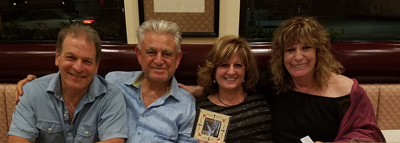
BEYOND WRITING
Beyond writing, is Stephanie’s activism. She has been politically active, since childhood, when she created a neighborhood newspaper at age eight, for a penny a copy, detailing all the things in the neighborhood that needed attention. Her parents helped her hand deliver her neighborhood news, and it made the rounds. By the time Stephanie was ten, her poetry had been published in children’s magazines, as her concern with issues, intensified. From adolescence, Vietnam to politics, she was always involved, and as she got older, her involvement with the Jewish community grew. She became active with the Jewish Federation of Los Angeles, and was asked to be part of a nine woman delegation traveling to the former Soviet Union, before Glasnost, to visit the underground Jewish Women’s groups in Moscow and Leningrad, and the groups of Second Generation in Refusal. She was there for several weeks, reporting on the situation, taping, and visiting the various groups. The most moving, were her time with the second generation, and her Shabbats spent with the Women and their families, behind dark curtains, in basements. On the holiday of Simchat Torah, in Leningrad, the Police came on horseback, demanding that Jews get off the streets. Stephanie was able to get the last interview with Ida Nudel, before Armand Hammer’s plane took her out of the former USSR, to Israel. Stephanie was able to meet with Sharansky, as well. As a result, Stephanie is in the process of writing a play about this courageous group, the Refuseniks. So little is known about them, and she wants to tell their stories…
Upon Stephanie’s return from the former Soviet Union, she worked with several of the other women of the group to secure the release of second generation, allowing them to come to the U.S. Once they were released, the parents were able to follow. It was a long, arduous, process, but moving and emotional.
Stephanie has spent a great deal of time in Africa. She stayed in Kenya , and traveled with the Masai, as well as the Moran. That trip was the first of many. In 1992, the UNITED NATIONS HIGH COMMISSION ON REFUGEES, approached the Writers Guild of America West, asking for six writers to accompany them to two war zones – Somalia and Bosnia. They would be the first ambassadors the UN would take to trouble spots, with the idea that they would come home, and write movies and tv, not only about what they’d seen, but the work of the U.N. Stephanie was chosen as one of the SIX WRITERS, to represent television writers. Among others on the trip, were Mike Farrell, the first spokesman for the UNHCR, and Phil Alden Robinson, who wrote, among other films, Field of Dreams. Phil was also behind the camera, documenting the trip for NIGHTLINE. It aired over two weeks.
In Somalia, they accompanied the women and children on the death march into Kenya. Death march, because the heat was extreme, and there was not enough food or water. They stayed in the relief workers’ encampment along the way, and in compounds, where they were not allowed to leave, boy soldiers holding them captive, with AK 47s. From there, they went into the refugee camps and hospitals in Kenya. They followed the refugees, and met with the leaders of the tribes, and made reports along the way.
In Bosnia, they based in Sarajevo, and traveled throughout the area, in the middle of the war zone. Each of the six writers was placed in their own tank, and went through the areas under fire and being bombed. They met with families, and at the request of then SENATOR AL GORE, they searched for the parents of one of his constituents, who had been reported missing. The UN representative found them, and Phil Robinson shot footage, as they were able to call their daughter, as bombs and shots, were firing all around them. As a thank you, the writers were invited to the inauguration of President Bill Clinton, and VP Al Gore.
Stephanie has been in the middle of four wars, in areas that started as research for her work, but the issues were so powerful, she became an activist for their cause, using her work as a way to bring people to the awareness.
Stephanie has taught workshops in prisons, from NY, to Los Angeles, and has worked with street gangs, helping them to use writing and improvisation as a tool to release and express. She has fought for the people of skid row, worked to feed the homeless, and the hungry, and has spent most of her career, as an activist within the Writers Guild of America, West, not only fighting for writers’ rights, but serving on committees meeting with network executives and producers, to elevate the image of the writer in television. She was the first writer to have publicity clause in her contracts, and brought her publicist into the writers guild, to work with groups of writers, to elevate their presence in the community. Stephanie is one of only 1,500 Lifetime Members , of the Writers Guild membership of app 18,000. She carries that distinction, proudly. And as a Jewish writer of television and theatre, Stephanie was asked by Hadassah, to be a founding member of their board, of the MorningStar Commission.
MorningStar Commission is a group of high profile, Jewish women in the entertainment business, chosen by Hadassah, to speak across the country, to raise awareness of the image of Jewish women as portrayed in television, film, and stage. On behalf of the Commission, Stephanie has spoken across the United States, bringing her unique experiences to audiences, highlighting the importance of how Jewish women are portrayed on screen, and stage. Or not portrayed, as the case has been. Mainstream Jewish women have been sorely absent from storytelling, and through the work of the Commission, this is slowly being eradicated. It has been an uphill battle, and Stephanie has helped lead the way – not only by her portrayals, but her fight against antisemitism, is well known. She is an outspoken advocate, and her work reflects this.
For Stephanie, there is no life without activism, without fighting for the rights of others, without giving voice to the voiceless. Her plays and tv films, are her way of bringing attention and light to the darkest areas of the world. It is her way of giving back, and she is grateful for the privilege. Stephanie believes it is a privilege to be able to be a successful writer, and to live the purpose behind her work. She cannot believe she,’gets,’ to do what she does. It is a gift to be able to bring light to the darkness, and most importantly, to be of service.
